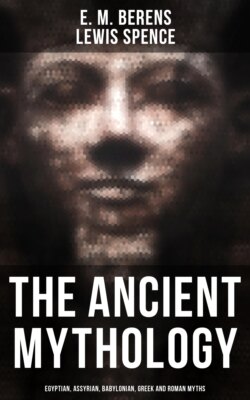Читать книгу The Ancient Mythology: Egyptian, Assyrian, Babylonian, Greek and Roman Myths - Lewis Spence - Страница 65
На сайте Литреса книга снята с продажи.
An Allegorical Interpretation of the Myth
ОглавлениеA truly allegorical elucidation of the myth of Ishtar's descent into Hades would depict Ishtar, as the goddess of fertility, seeking in the underworld for her husband, the sun-god, slain by the icy breath of winter. During her sojourn in the nether regions all fertility ceases on the earth, to be resumed only when she returns as the joyful bride of the springtide sun. The surrender of her clothing and jewels at the seven gates of Aralu represents the gradual decay of vegetation on the earth, and the resumption of her garments the growing beauty and verdure which mark her return. Another hypothesis identifies Ishtar with Dawkina, goddess of the earth, wife of Ea and therefore mother as well as consort of Tammuz. According to this view Ishtar represents not the fertility of the earth, but the earth itself, deprived of its adornments of flowers and leafage by the approach of winter, or variously, by the burning heat of summer. The waters of life, with which she sprinkles and restores her husband,8 are the revivifying rains which give to the sun-god his youthful vigour and glory. Against this view it has been urged (e.g. by Sir James Frazer) that "there is nothing in the sun's annual course within the temperate and tropical zones to suggest that he is dead for half or a third of the year, and alive for the other half or two-thirds."
Alternatively it is suggested that Tammuz is a god of vegetation, and that Ishtar doubles the rôle. The slaying of Tammuz and the journey of Ishtar would thus represent two distinct myths, each typifying the decay and subsequent revival of vegetation. Other instances may be recalled in which two myths of the same class have become fused into one. This view, then, presents some elements of probability; not only Tammuz but most of his variants appear to possess a vegetable significance, while the Ishtar type is open to interpretation on the same lines. Thus Adonis is associated with the myrrh-tree, from whose trunk he was born, and Osiris with the tamarisk, used in the ritual connected with his cult, while Attis after his death became a pine-tree. Tammuz himself was conceived of as dwelling in the midst of a great world-tree, whose roots extended down to the underworld, while its branches reached to the heavens. This tree appears to have been the cedar, for which the ancient Babylonians had an especial reverence. One feature which leads us to identify the deities of this class, both male and female, with gods of vegetation is their association with the moon. Osiris is regarded, and with much reason, as a moon-god; in one of her aspects Aphrodite is a lunar deity, while a like significance belongs to Proserpine and to the Phœnician Ashtoreth. Ishtar herself, it is true, was never identified with the moon, which in Babylonia was a male divinity; yet she was associated with him as his daughter. Among primitive peoples the moon is believed to exercise a powerful influence on vegetation, and indeed on all manner of growth and productivity. The association of a god with the moon therefore argues for him also a connexion with vegetation and fertility. It may be remarked, in passing, that a lunar significance has been attached by some authorities to the story of Ishtar's descent into Hades, and to kindred myths. It is held that the sojourn of the goddess in Aralu typifies a lunar eclipse, or perhaps the period between the waning of the old moon and the appearance of the new. But, as has been said, the ancient Babylonians saw in the luminary of night a male deity, so that any lunar characteristics pertaining to Ishtar must be regarded as of merely secondary importance.
